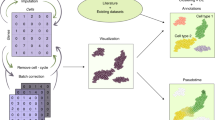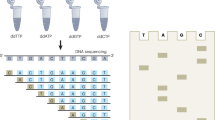Abstract
We have not yet reached a point at which routine sequencing of large numbers of whole eukaryotic genomes is feasible, and so it is often necessary to select genomic regions of interest and to enrich these regions before sequencing. There are several enrichment approaches, each with unique advantages and disadvantages. Here we describe our experiences with the leading target-enrichment technologies, the optimizations that we have performed and typical results that can be obtained using each. We also provide detailed protocols for each technology so that end users can find the best compromise between sensitivity, specificity and uniformity for their particular project.
This is a preview of subscription content, access via your institution
Access options
Subscribe to this journal
Receive 12 print issues and online access
$259.00 per year
only $21.58 per issue
Buy this article
- Purchase on Springer Link
- Instant access to full article PDF
Prices may be subject to local taxes which are calculated during checkout





Similar content being viewed by others
Change history
12 April 2010
In the version of this article initially published, the publication date was incorrectly designated as 28 January 2009 instead of 28 January 2010. The error has been corrected in the HTML and PDF versions of the article.
References
Sanger, F., Nicklen, S. & Coulson, A.R. DNA sequencing with chain-terminating inhibitors. Proc. Natl. Acad. Sci. USA 74, 5463–5467 (1977).
International Human Genome Sequencing Consortium. Finishing the euchromatic sequence of the human genome. Nature 431, 931–945 (2004).
Mardis, E.R. The impact of next-generation sequencing technology on genetics. Trends Genet. 24, 133–141 (2008).
Shendure, J. & Ji, H. Next-generation DNA sequencing. Nat. Biotechnol. 26, 1135–1145 (2008).
Saiki, R.K. et al. Primer-directed enzymatic amplification of DNA with a thermostable DNA polymerase. Science 239, 487–491 (1988). This paper was the first description of PCR, which, coupled to electrophoretic sequencing, is the primary conventional method for targeted variation analysis.
Cho, R.J. et al. Genome-wide mapping with biallelic markers in Arabidopsis thaliana . Nat. Genet. 23, 203–207 (1999).
Wang, D.G. et al. Large-scale identification, mapping, and genotyping of single-nucleotide polymorphisms in the human genome. Science 280, 1077–1082 (1998).
Fredriksson, S. et al. Multiplex amplification of all coding sequences within 10 cancer genes by Gene-Collector. Nucleic Acids Res. 35, e47 (2007).
Meuzelaar, L.S., Lancaster, O., Pasche, J.P., Kopal, G. & Brookes, A.J. MegaPlex PCR: a strategy for multiplex amplification. Nat. Methods 4, 835–837 (2007).
Varley, K.E. & Mitra, R.D. Nested patch PCR enables highly multiplexed mutation discovery in candidate genes. Genome Res. 18, 1844–1850 (2008).
Barnes, W.M. PCR amplification of up to 35-kb DNA with high fidelity and high yield from lambda bacteriophage templates. Proc. Natl. Acad. Sci. USA 91, 2216–2220 (1994).
Craig, D.W. et al. Identification of genetic variants using bar-coded multiplexed sequencing. Nat. Methods 5, 887–893 (2008).
Cronn, R. et al. Multiplex sequencing of plant chloroplast genomes using Solexa sequencing-by-synthesis technology. Nucleic Acids Res. 36, e122 (2008).
Harismendy, O. & Frazer, K. Method for improving sequence coverage uniformity of targeted genomic intervals amplified by LR-PCR using Illumina GA sequencing-by-synthesis technology. Biotechniques 46, 229–231 (2009).
Hodges, E. et al. Genome-wide in situ exon capture for selective resequencing. Nat. Genet. 39, 1522–1527 (2007).
Okou, D.T. et al. Microarray-based genomic selection for high-throughput resequencing. Nat. Methods 4, 907–909 (2007).
Hamady, M., Walker, J.J., Harris, J.K., Gold, N.J. & Knight, R. Error-correcting barcoded primers for pyrosequencing hundreds of samples in multiplex. Nat. Methods 5, 235–237 (2008).
Hamming, R. Error detecting and error correcting codes. Bell Syst. Tech. J. 29, 147–161 (1950).
Ikegawa, S., Mabuchi, A., Ogawa, M. & Ikeda, T. Allele-specific PCR amplification due to sequence identity between a PCR primer and an amplicon: is direct sequencing so reliable? Hum. Genet. 110, 606–608 (2002).
Dressman, D., Yan, H., Traverso, G., Kinzler, K.W. & Vogelstein, B. Transforming single DNA molecules into fluorescent magnetic particles for detection and enumeration of genetic variations. Proc. Natl. Acad. Sci. USA 100, 8817–8822 (2003).
Tawfik, D.S. & Griffiths, A.D. Man-made cell-like compartments for molecular evolution. Nat. Biotechnol. 16, 652–656 (1998).
Tewhey, R. et al. Microdroplet-based PCR enrichment for large-scale targeted sequencing. Nat. Biotechnol. 27, 1025–1031 (2009). This paper describes the performance of the RainDance technology, which facilitates multiplex PCR by compartmentalizing primer pairs in distinct microdroplet populations that are then mixed and thermocycled in aggregate.
Dahl, F., Gullberg, M., Stenberg, J., Landegren, U. & Nilsson, M. Multiplex amplification enabled by selective circularization of large sets of genomic DNA fragments. Nucleic Acids Res. 33, e71 (2005).
Porreca, G.J. et al. Multiplex amplification of large sets of human exons. Nat. Methods 4, 931–936 (2007).
Dahl, F. et al. Multigene amplification and massively parallel sequencing for cancer mutation discovery. Proc. Natl. Acad. Sci. USA 104, 9387–9392 (2007).
Faruqi, A.F. et al. High-throughput genotyping of single nucleotide polymorphisms with rolling circle amplification. BMC Genomics 2, 4 (2001).
Antson, D.O., Isaksson, A., Landegren, U. & Nilsson, M. PCR-generated padlock probes detect single nucleotide variation in genomic DNA. Nucleic Acids Res. 28, E58 (2000).
Hardenbol, P. et al. Multiplexed genotyping with sequence-tagged molecular inversion probes. Nat. Biotechnol. 21, 673–678 (2003).
Lizardi, P.M. et al. Mutation detection and single-molecule counting using isothermal rolling-circle amplification. Nat. Genet. 19, 225–232 (1998).
Hardenbol, P. et al. Highly multiplexed molecular inversion probe genotyping: over 10,000 targeted SNPs genotyped in a single tube assay. Genome Res. 15, 269–275 (2005).
Nilsson, M. et al. Padlock probes: circularizing oligonucleotides for localized DNA detection. Science 265, 2085–2088 (1994).
Landegren, U. et al. Molecular tools for a molecular medicine: analyzing genes, transcripts and proteins using padlock and proximity probes. J. Mol. Recognit. 17, 194–197 (2004).
Turner, E.H., Lee, C., Ng, S.B., Nickerson, D.A. & Shendure, J. Massively parallel exon capture and library-free resequencing across 16 genomes. Nat. Methods 6, 315–316 (2009). This paper demonstrates a substantially optimized protocol for using molecular inversion probes for exon capture that also enables library-free integration of multiplex capture and next-generation sequencing.
Deng, J. et al. Targeted bisulfite sequencing reveals changes in DNA methylation associated with nuclear reprogramming. Nat. Biotechnol. 27, 353–360 (2009).
Zhang, K. et al. Digital RNA allelotyping reveals tissue-specific and allele-specific gene expression in human. Nat. Methods 6, 613–618 (2009).
Li, J.B. et al. Genome-wide identification of human RNA editing sites by parallel DNA capturing and sequencing. Science 324, 1210–1213 (2009).
Lovett, M., Kere, J. & Hinton, L.M. Direct selection: a method for the isolation of cDNAs encoded by large genomic regions. Proc. Natl. Acad. Sci. USA 88, 9628–9632 (1991).
Parimoo, S., Patanjali, S.R., Shukla, H., Chaplin, D.D. & Weissman, S.M. cDNA selection: efficient PCR approach for the selection of cDNAs encoded in large chromosomal DNA fragments. Proc. Natl. Acad. Sci. USA 88, 9623–9627 (1991).
Albert, T.J. et al. Direct selection of human genomic loci by microarray hybridization. Nat. Methods 4, 903–905 (2007). This was one of three papers that described solid-phase, hybridization-based enrichment of targeted sequences in shotgun DNA libraries using programmable microarrays.
Gnirke, A. et al. Solution hybrid selection with ultra-long oligonucleotides for massively parallel targeted sequencing. Nat. Biotechnol. 27, 182–189 (2009). This paper was the first description of the method, now commercialized by Agilent, for solution-phase hybridization-based capture using complex libraries of RNA 'bait' to capture from a shotgun DNA 'pond' library.
Hodges, E. et al. Hybrid selection of discrete genomic intervals on custom-designed microarrays for massively parallel sequencing. Nat. Protocols 4, 960–974 (2009).
Li, H. & Durbin, R. Fast and accurate short read alignment with Burrows-Wheeler transform. Bioinformatics 25, 1754–1760 (2009).
Li, H., Ruan, J. & Durbin, R. Mapping short DNA sequencing reads and calling variants using mapping quality scores. Genome Res. 18, 1851–1858 (2008).
Bentley, D.R. et al. Accurate whole human genome sequencing using reversible terminator chemistry. Nature 456, 53–59 (2008).
Quail, M.A. et al. A large genome center's improvements to the Illumina sequencing system. Nat. Methods 5, 1005–1010 (2008).
Acknowledgements
We thank D. MacArthur, Q. Ayub and C. Tyler-Smith for their work on long PCR and subsequent analyses, P. Akan, A. Palotie, P. Tarpey, H. Arbury and M. Humphries for their work on hybrid capture and E. Sheridan for critical reading of the standard operating procedures. This work was supported by the Wellcome Trust grant WT079643 and by US National Institutes of Health National Human Genome Research Institute grants 5R21HG004749 and 5R01HL094976.
Author information
Authors and Affiliations
Corresponding authors
Ethics declarations
Competing interests
The authors declare no competing financial interests.
Supplementary information
Supplementary Text and Figures
Supplementary Table 1 and Supplementary Protocols 1–6 (PDF 2929 kb)
Rights and permissions
About this article
Cite this article
Mamanova, L., Coffey, A., Scott, C. et al. Target-enrichment strategies for next-generation sequencing. Nat Methods 7, 111–118 (2010). https://doi.org/10.1038/nmeth.1419
Published:
Issue Date:
DOI: https://doi.org/10.1038/nmeth.1419
This article is cited by
-
Exploring genetic diversity and variation of Ovar-DRB1 gene in Sudan Desert Sheep using targeted next-generation sequencing
BMC Genomics (2024)
-
Technical strategy for monozygotic twin discrimination by single-nucleotide variants
International Journal of Legal Medicine (2024)
-
Integrating genomic sequencing resources: an innovative perspective on recycling with universal Angiosperms353 probe sets
Horticulture Advances (2024)
-
Highly multiplexed targeted sequencing strategy for infectious disease surveillance
BMC Biotechnology (2023)
-
Genetic diversity analysis and variety identification using SSR and SNP markers in melon
BMC Plant Biology (2023)



